Buttercups are usually considered not edible. In fact, I think they were the first plant I learned not to eat when I was just a few years old. Of the 2,252 species in the family and some 600 buttercups in the genus perhaps a dozen and a half squeak into the edible realm. Potential famine food. I also learned at an early age they grow in wet places such as near quicksand.
There is something of a debate whether true “quicksand” exists in North America. I don’t see why not. It’s liquefied soil, usually sand kept in suspension by water flowing up from underneath. Directly behind the first house I lived in there were buttercups and quicksand. Cows were known to drown there. In fact when I was four or five I fell head first into said. Was rescued by the family dog named “Sister” who wasn’t much more than a puppy herself. Thus exploring buttercups and I go way back along with falling into things. (By the way if you do find yourself in quicksand, float as you would in a pool.)
The only use for our buttercups was the childhood game of holding the yellow blossom under someone’s chin to see if they “liked” butter. The chin always lights up with a yellow glow. It took scientists a century to figure out why. You can read a web page about it here or you can read the entire article below.)
Buttercups, like horseradish, engage in chemical warfare. In horseradish the heat one tastes comes from crushing cells that hold two different chemicals apart which are only peppery when they combine. This is to discourage consumption by me, thee and the denizens of nature. The buttercup is similar in that the offending chemical, a glycoside called Ranunculin, is not a problem until the plant’s cells are crushed. Then an almost instant enzyme reaction turning Ranuculin into Protoanemonin, a bitter, irritating, yellow oil. The animals most bothered by buttercups are grazing cows then horses, sheep and pigs, the latter two sometimes suffering paralysis. Humans are rarely poisoned by buttercups because they taste so bad. It is not fatal in small amounts but a significant irritant that can make you ill with gastric distress.
So, which part is toxic? The entire plant: Sap, flowers, seeds, and leaves but the greatest concentration is in the yellow flowers, next are the shoots which have one-sixth as much. However, dried the plant can be eaten by cows. Heat also destroys the toxin. According to the late poisonous plant expert John M.Kingsbury, “as far as has been determined they [Buttercups) all contain the same toxic principle, although in varying amounts, and produce an equivalent syndrome.” Thus our goal is to use species that have small amounts and/or which can be easily removed. R. sceleratus has 2.5% Protoanemonin (dry weight basis) and R. bulbosa 1.45%. R. repens has only 0.27%.
Which ones have been consumed? Ranunculus abortivus (leaves boiled) Ranunculus acris (leaves boiled) Ranunculus aquatilis (entire plant boiled) Ranunculus bulbosus (roots, much boiled or after drying, young flowers pickled, ) Ranunculus californicus (seeds parched and pulverized, there are about 30 per pod and are approximately 18% protein, 26% oil) Ranunculus cynbalaria (mature leaves boiled) Ranunculus edulis (tubers, young stems and leaves boiled) Ranunculus ficaria (young leaves eaten raw in salads, bleached stems cooked and eaten, bulbils — both leaf axils and roots — cooked with meat and eaten, flower buds substituted for capers) Ranunculus inamoenus (roots cooked) Ranunculus lapponicus (leaves and stems boiled) Ranunculus occidentalis var. eisenii (seeds parched) Ranunculus occidentalis var. rattanii (seeds parched) Ranunculus pallasii (shoots and young roots boiled) Ranunculus polyanthemos (leaves pickled first in salt water then added to cheese) Ranunculus reptans (roots cooked on hot rocks) Ranunculous repens (leaves boiled, flowers pickled after boiling) Ranunculus sativus (raw stems eaten as is) and Ranunculus sceleratus (leaves boiled and or fermented.) R. acris, R. bulbosa, R. edulis, R. ficaria, R. repens, and R. sceleratus were introduced from Europe.
Among the Native Americans who consumed buttercups in various ways were the: Cherokee, Gosiute, Miwok, Neeshenam, Iroquois, Acoma, Inuktitut (Eskimos) Keres, Laguna, Mendocino, Pomo, Hesquiat, Makah, Quileute, and Costanoan.
John Lightfoot, who wrote Flora Scotica in 1777 said “not withstanding this corrosive quality, the roots when boiled become so mild as to become eatable.” Merritt Fernald, the grand wild food man of Harvard yard, said the R. bulbosus bulbils if overwintered and dry become mild and sweet. Medicinally the buttercups have been used in a wide variety of ways. The Illinois-Miami used them to treat arrow and later gunshot wounds, the Cherokee as a poultice on abscesses, as a sedative and for sore throats. The Iroquois used a decoction for epilepsy, blood diseases, sore eyes, stomach issues, stiff muscles, snake bite, toothaches, as an emetic, to counter poisons and to dry up smallpox sores. The Meskwaki used them externally to stop nosebleeds. John Bartram, 1751, reported Buttercups were used for syphilis, asthma, rheumatism, pneumonia and other ailments. The juice has been used to remove warts. Extracts of R. sceleratus are good against plant fungus. The native Florida Buttercup. R. abortivus was also considered a remedy for syphilis. I don’t want to know about application methods.
The genus name, Ranunculus, is Dead Latin for small frog. Pliny the Elder, 23-79 AD, used that name for the buttercup which should tell you man has been familiar with the plant family for a long time. Farmers long ago thought cows eating buttercups would improve the color of their butter. Some farmers even rubbed the yellow blossoms on the udders. Considering the flowers can be irritating that probably did not work out well. However, a tea made from buttercups and poured on the ground drives earthworms to the surface. The yellow flowers yield a light fawn dye if alum is used as a mordant, green with chrome as the mordant, and yellow with tin as the mordant. Mordants set the color on the fabric.
Why Buttercups Reflect Yellow
As reported in Phys.Org scientists have discovered why buttercups reflect yellow on chins – and it doesn’t have anything to do with whether you like butter. The new research sheds light on the children’s game and provides insight into pollination. Researchers found the distinctive glossiness of the buttercup flower (Ranunculus repens), which children like to shine under the chin to test whether their friends like butter, is related to its unique anatomical structure. Their findings were published 14 December, 2011, in the Royal Society journal Interface.
The researchers discovered that the buttercup petal’s unique bright and glossy appearance is the result of the interplay between its different layers. In particular, the strong yellow reflection responsible for the chin illumination is mainly due to the epidermal layer of the petal that reflects yellow light with an intensity that is comparable to glass. Scientists have been interested in how the buttercup flower works for over a century. They have previously shown that the reflected color is yellow due to the absorption of the colors in the blue-green region of the spectrum by the carotenoid pigment in the petals. As the blue-green light is absorbed, the light in the other spectral regions (in this case, primarily yellow) is reflected. It has also been known for many years that the epidermal layer of the petals is composed of very flat cells, providing strong reflection.
This new study shows how the buttercup’s exceptionally bright appearance is a result of a special feature of the petal structure. The epidermal layer of cells has not one but two extremely flat surfaces from which light is reflected. One is the top of the cells, the other exists because the epidermis is separated from the lower layers of the petal by an air gap. Reflection of light by the smooth surface of the cells and by the air layer effectively doubles the gloss of the petal, explaining why buttercups are so much better at reflecting light under your chin than any other flower.
The researchers also found that the buttercup reflects a significant amount of UV light. As many pollinators, including bees, have eyes sensitive in the UV region, this provides insight into how the buttercup uses its unique appearance to attract insects. Dr. Silvia Vignolini, lower left, from the University of Cambridge’s Department of Physics (Cavendish Laboratory), explained the importance of the buttercup’s unique appearance: “Although many different factors, such as scent and temperature, influence the relationships between pollinators and flowers, the visual appearance of flowers is one of the most important factors in this communication. Flowers develop brilliant color, or additional cues, such as glossiness – in the case of the buttercup – that contribute to make the optical response of the flower unique. Moreover, the glossiness might also mimic the presence of nectar droplets on the petals, making them that much more attractive.”
Dr. Beverley Glover, Department of Plant Sciences, said: “This phenomenon has intrigued scientists and laymen alike for centuries. Our research provides exciting insight into not only a children’s game but also into the lengths to which flowers will go to attract pollinators.” Professor Ulli Steiner, from the Nanophotonics Center at the Cavendish Laboratory, the University of Cambridge’s Department of Physics, said: “It is fun to revisit a problem that is more than one century old and, using modern methods, discover something new. The strong collaboration between Physics and the Plant Sciences has enabled this.”
Next topic to be researched: Quicksand… For you historical buff there once was a Buttercup, Texas. And for 11 weeks in 1968 the song on the top of the charts was “Build Me Up Buttercup” by the Foundation.

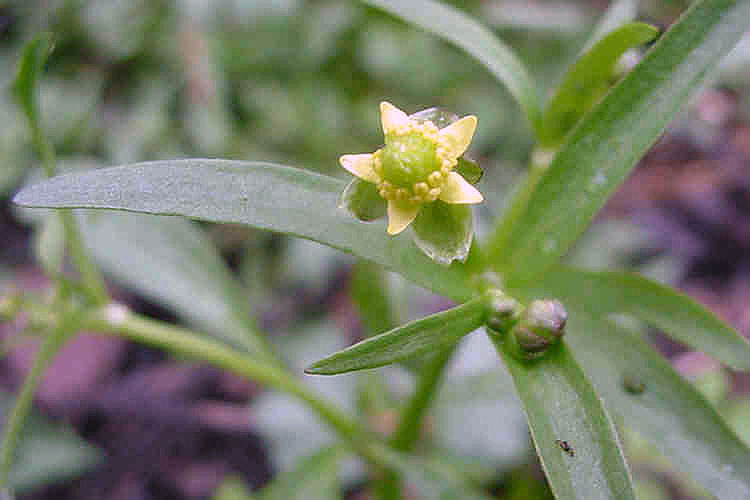
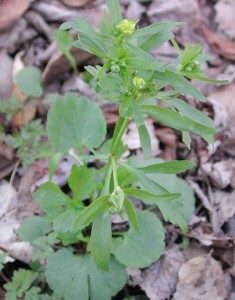
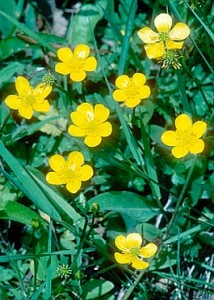
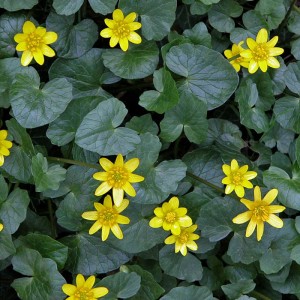
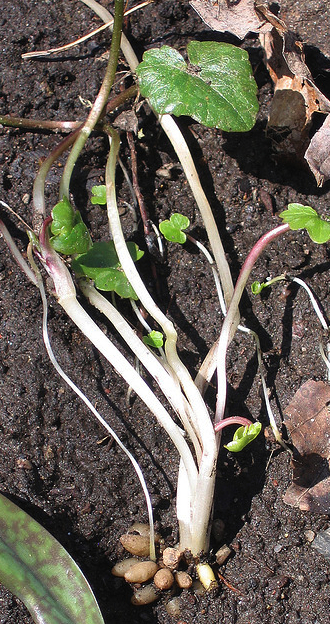
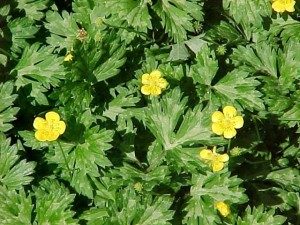





Have you or would you ever eat any of the buttercups mentioned? How reliable are the reports of edibility?
Just ate one and didn’t die (or feel any ill effects). Probably not a good idea to eat a whole bunch of them.
are you still alive Ben?
Are buttercups poisonous, or not? (To humans)
If you mean the ones you find in wet spots in northern areas with waxy yellow blossoms, yes.
I would guess it depends on what kind you have, what part you are eating, how young it is, and how you prepare the parts. I tried steaming the young greens and ate with lots of butter. Yum!
“The length flowers will go to attract polinators” It is easier to believe plants are sentient than to give credit to God? We live in the age of great knowledge and no understanding.
Good God is Great!
It’s not a phrase meant to be taken literally, I am pretty sure Mr. Deane does not imply that plants have brains and made conscious decisions to change their traits, if you made use of the great knowledges you mentioned you would know that evolution favors plants that have attractive traits to pollinators and makes them thrive.
The Bible says, “Behold, I have given you every plant yielding seed that is on the face of all the earth, and every tree with seed in its fruit. You shall have them for food.”
So why did God make buttercups and many other plants poisonous? Why did He make some plants contain such deadly poison that if you eat any part of the plant, you will die?
Does it not have something to do with man’s fallen state?
Are Buttercup toxic to chickens. They seem to like it so far after several
feedings, but do not want to make my chickens sick.
Yes it is, one of our younglings died from the poisoning. Don’t know how much it takes to kill a chicken, but I don’t intend to find out.
I only feed chickens dandelions or grass. They love dandelion greens (when they are young and tender).
Thanks for the insight. I love the understanding that Buttercups can be beautiful and tolerable, but a nuisance to tri to control. Best to try to minimize animals having to eat, boil or dry in various recipe, and understand that it can be used as a herbal remedy and medicine.
They are back! I thought I had them pretty much under control. Years of black landscape fabric, vigorous vigilance and incessant weed pulling seemed to work but this wet spring and poorly drained soil has become a breeding ground for them. I’m so disgusted by the fig Ranunculus that I won’t eat them, boiled, pickled, dried, or any which way. What I’d like to know is how to eradicate them from under my organic figs, berries and flower beds. Any suggestions?
I used one hand to pull, the other to dig with a trowel. I found out the buttercup has primary purplish roots, then secondary fiber roots ( I don’t major in horticulture, those are my jargon) . It may have running buttercup roots ( at least I pulled some up). This is the first time during 20 yrs that we have buttercups shown up in our yard. Young buttercups are easy to break off the stems, so roots must be dug out. The areas you pulled, pour boiling water over to kill the remaining roots; IF you don’t have other beautiful things around. THIS is the most eco-friendly way of stopping buttercups spreading. OR you may spray with white vinegar (straight), that will kill!
Hi ! just wondering if I clear a patch of land where buttercups grow in profusion and then plant corn or tomatoes, would the veggies be affected by the soil ?
thanks…
That shouldn’t be a problem.
thank you so much !
There are studies going on in New Zealand by AgResearch (Govt scientific agency?) into how to deal with Ranunculus Acris (Giant Buttercup) that finds pasture conditions in much of the country very favourable (has been declared a pest in many provinces). Following protocols from the study, one way we have found it extremely good cattle feed is to pre-top (mow as for hay), allow to wilt (dry) for an hour or three to allow the alkaloid to go off as a gas, feed to animals. R. Acris contains many minerals and hasn’t caused any issues with milking cows on our organic farm. This study is also happening on non-organic farms, not sure of results there.
Hello, I’m doing a research paper on foraging and need scholarly sources, so thank you for pointing out the studies by AgResearch 🙂
When you say “one way we have found…” is that referring to yourself/your farm or some larger organization? Is there any more info you have on this? It would be of great use for me to contrast such specific academic and non-academic knowledge.
Hopefully you see this before 4/1, when my paper is due! I’d love to have a conversation about it
I ate a couple leaves raw. Yes, mildly horseradish like. I plan on boiling a few before eating sometime in a few days.
are buttercup roots good to lower blood sugar,I read an article that buttercup roots can possibly cure diabeties 2
In the 60’s we used dandelions. We’d ask if you liked butter then we popped the flower off under our friend’s chin and the pollen made a yellow spot,lol. We didn’t have any butter cups around.
Mistaking it for some kind of garden parsley, I recently ate some Ranunculus repens. Only 2 or 3 leaves. Within 10 mins I had mild stomach pain which worsened to real discomfort – the “gastric distress” referred to in the article. This lasted for two days as the stuff passed through my system.
It sounds from this sad story that consumption can indeed lead to death:~ From the Kentish Chronicle, 21 May, 1864.
SINGULAR DEATH OF A Child.
An inquest was held on Monday at the “Bull Hotel,” Dartford, before C. J. Carttar, Esq., coroner, on the body of a child named Sarah Elizabeth Heron, aged six years.
It appeared from the evidence of the mother and father of the child that some time before death the deceased had complained of being very unwell, and in great pain about the body and legs. The mother afterwards discovered that the deceased had been eating buttercups from a field close by, and sent for a powder from a chemist’s, but as the deceased vomited a great deal and presented every appearance of having been poisoned, she hastened off for the parish surgeon, Mr. Martin, who did not make his appearance at the house till the child was dead. A post mortem examination had been made which clearly proved the deceased had been poisoned by eating buttercups, and the jury brought in a verdict to that effect, but thought that Mr. Martin was to blame for not having attended sooner upon the deceased.
I decided one spring not to weed a certain patch of super hardy buttercups every year, realising who decides that a plant is a weed or not? They provide moisture and ground cover and a burst of yellow for my other plants and make the area look lush and tidy. Just other areas I have to prevent from spreading. Can’t beat’em so accomodate into my garden.
I feel the same way. Fight weeds with weeds. I don’t bother with mats or mulch, just plant things that will grow into a carpet and choke off everything else. Who says grass is king? A nice lawn of dichondra looks great.
I don’t like to pour boiling water over buttercups because I always find so many earth worm surrounding the roots.
Butter cup is new to me- Eating weeds is not. Generally nibble test a new plant to see any medicinal quailties; Buttercup has been one of the more wild introductions. Slight bitter… then BLAM! Acrid spicy pepper out of no where- and it seems to intensify upon a second sample.
I can’t imagine anyone actively finishing eating a single leaf on purpose. There’s no way. If there’s more of that compound in the flowers- I have an even harder time believing anyone ever died from eating them- the taste is so intense.
Stellar article by the way. Thank you for posting this.!